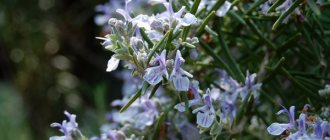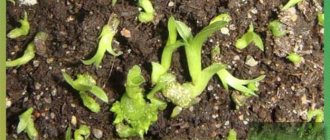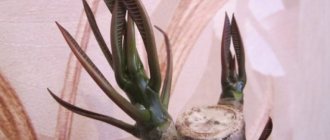Author: Elena N. https://floristics.info/ru/index.php?option=com_contact&view=contact&id=19 Category: Garden plants Published: February 14, 2019Last edits: November 03, 2020
- When to plant
- Growing conditions
- How and when to collect seeds
- Aubrieta deltoidea
plant (lat. Aubrieta), or aubrieta, belongs to the genus of creeping evergreen herbaceous perennial flowering plants of the Brassica family, numbering 12 species. Aubrieta is grown in rock gardens and gardens throughout Europe, and in nature it can be found in the Balkans, Italy, the south of France, Asia Minor and even in South America, where it lives on rocks and river banks. The flower received its Latin name in honor of the French artist Claude Aubrier, who worked in the genre of botanical illustration, and in our country it is called... windbag. The blooming aubrieta is a bright continuous carpet. A characteristic feature of the plant is that it retains its beautiful foliage even in winter.
Varieties and types of aubrietta flower
Aubrieta is an evergreen plant, which is a low-growing shrub. From the outside it appears as if a carpet covers the garden plot. The leaves have different shapes, resembling a lancet or ellipse. Their color is usually gray-green. The flowers are small, consist of four petals, do not exceed 1 cm in diameter. They can be regular, double or semi-double, and differ in shades.
Appearance of the aubriet
Among the numerous varieties and species of plants, the most popular are:
- Deltoid shaving. Blue or purple flowers appear in May and delight gardeners throughout the month. This is the most common type of plant, giving rise to almost all existing varieties. Due to the color of the flowers, it is known as the “lilac bush.” The leaves are characterized by a deltoid shape and have toothed edges, usually one or two. The shrub itself grows no more than 15 cm in height.
- Hybrid aubrieta or cultural. It blooms in spring, as if welcoming the arrival of sunny and warm days. Hybrid plants include artificially bred plants. Their flowers have a variety of shades; they can be red, white, violet, pink, purple. For example, the Audrey variety has several forms; the buds are raspberry or dark purple. The flowers grow so thickly, reminiscent of floating clouds, the names Giant Falls and Cote d'Azur speak for themselves. Some varieties have foliage that combines two shades.
- Graying shaving. Its leaves are distinguished by a silvery color, the flowers are usually light lilac.
- Aubrieta Columnar. Its stems are dense, thick, and fluffy pile is noticeable on the leaves. The flowers are also quite large, different from other varieties and species. They are usually pink or red.
- Aubrieta Campbell has large lilac flowers of different shades. They appear in May and last for more than a month.
Stunning Campbell variety
Varieties
The genus includes valuable varieties obtained by crossing the deltoid aubrieta with other species. The first copies were created in England. Most of the available hybrids are of the deltoid variety. They are usually propagated vegetatively.
The most popular varieties:
- "Variegata" is a low-growing perennial that forms a dense lawn, covered with blue-violet small flowers. The leaves are decorative, with white edges.
- "Blaumeise" - grows up to 15 cm. Flowering - from April to June, produces many star-shaped flowers, about 5 cm in diameter. The variety grows quickly - the bushes reach 80 cm in diameter after 2 years of cultivation. After flowering, it is worth trimming the faded shoots.
- "Alba" - with white flowers.
- "Aurea" - grows up to 15 cm, has yellow edges of leaf blades and bluish-lavender flowers.
- "Argenteovariegata" - shoot height 20 cm, striped yellow leaves, pink flowers appear in April.
- Group “Audrey” - consists of five varieties (Red, Blue Shades, Purple Shades, Deep Purple Compact, Deep Blue Shades) reaching a bush height of 10 cm.
Photo. Variety "Audrey Purple Shades"
- Axcent group - includes 7 varieties with different colors of large flowers (Dark Red, Burgundy, Glacier Light Blue with Eye, Glacier Deep Purple, Glacier Lilac, Glacier Light Blue, Violet with Eye Improved - those with the word "Glacier" in the name - “glacier” are distinguished by good winter hardiness), among them are plain and with an eye. The bushes grow up to 15-20 cm.
Photo. “Axcent Glacier Blue” is a variety that reaches 10 cm. Small purple flowers completely cover the bush, creating a wonderful fragrant cushion to which butterflies and other insects flock.
- "Blaumeise" - grows up to 5 cm, large blue flowers appear in April-May.
- "Blue Emperor" - reaches 15 cm, purple-blue flowers develop in April-May.
- "Blue King" - bush height - 15 cm, flowers are blue and purple, bloom in April - May.
- "Burgundy" is a variety with large red flowers with a yellow center. The bushes reach a diameter of 40 cm and about 20 cm in height. Decorative evergreen leaf blades are distinguished by a jagged edge. Leaves decorate the garden all year round. The perennial is extremely resistant to high temperatures. It is planted at a distance of 20 cm due to its strong growth.
- "Stadtpark" is a variety with purple, delicate flowers. The perennial grows up to 15 cm. In April and May it blooms profusely, forming wide multi-colored bushes 60 cm wide. It looks original on walls and in rock gardens.
- "Bob Sanders" - shoots up to 20 cm high, forms double red-violet flowers that appear in April-May.
- “Bressingham Pink” – low bushes (10 cm), double, pink flowers.
Photo. Bressingham Pink variety
- "Bressingham Red" - bush height - 10 cm, plants form single pink-red flowers appearing in April - early May.
- "Doctor Mules" Doctor Mules - shoot height reaches 10 cm, flowers are blue-violet.
- "Blue Glacier" Glacier Blue - shoots reach 10 cm, with purple flowers.
- "Hamburger Stadtpark" Hamburger Stadtpark - reaches a bush height of 5 cm, forms small, simple, dark lilac flowers.
- "Tauricola" Tauricola - with a spherical shape, small blue flowers.
Photo. Aubrieta variety "Tauricola"
- "Red Carpet" Red Carpet - grows up to 10 cm, produces dark red flowers that bloom in April.
- "Winterberg" Winterberg - aubrieta variety grows up to 10 cm, with white, double flowers.
Today, few varieties are propagated from seeds. Among them are common:
- Royal group - plants reach a height of 10 cm, varieties with different colors are available:
- lavender color (“Royal Blue”);
- purple-red (“Royal Red”);
- pink-violet (“Royal Violet”);
- violet-blue (“Royal Violet”);
- Cascade group - its representatives reach a height of up to 10 cm, bloom in April - May, you can find varieties:
- dark blue (“Cascade Blue”);
- purple (“Cascade Purple”);
- carmine red (“Cascade Red”).
Fast and steady growth is characteristic of the hybrids of the Audrey F1 group, which grow to a height of 10-15 cm. 3 varieties are available with purple-blue, violet and red flowers. 'Pixie Pearls' - Grows up to 10cm tall and produces white flowers.
Planting a plant
To plant aubrieta you need seeds. They are either immediately placed in the ground or in special containers, waiting for the seedlings to appear. In the latter case, young shoots grow at home. They gain strength before landing in open ground. The main thing is to use suitable soil when sowing.
Planting by seeds
Coleus flower - care and cultivation in open ground
When growing aubretia from seeds, they are planted when night frosts are definitely not coming back. Usually this is May. You can also start the procedure in September.
Note! Autumn time is considered more preferable for planting. This is due to the large number of weeds in summer. They will interfere with the growth of the bush.
In order for aubrieta to bloom in the garden next year, cultivation from seeds should be carried out based on the recommendations:
- Treat the seeds with potassium permanganate, which will disinfect them. Then leave them in the growth stimulator for 10-12 hours.
- Prepare the planting site by digging and loosening the soil. If there is a large amount of clay, add sand. Get rid of stones so that the soil is homogeneous.
- Water the soil and make grooves leaving 15 cm between them.
- Place the seeds, cover with sand and moisten the soil.
- Cover with film until shoots appear. This usually happens within 2-3 weeks.
Planting seedlings
Perennial Aubrieta is planted for seedlings in February. The seeds must be treated in advance with a solution of potassium permanganate. This is an excellent antiseptic that gets rid of bacteria and fungi.
Abundant flowering plant
Evergreen obrietta, how to grow from seeds, step-by-step instructions:
- Prepare separate containers. It is better not to use boxes for seedlings, so as not to injure the roots of the plant in the future. They are fragile and try to avoid any manipulation with them.
- Fill the container with soil by mixing garden soil and sand in equal proportions.
- Place the seeds, sprinkle them with sand and moisten them a little.
- Cover with film and put in a warm place. The temperature at home should not fall below +18 ℃.
- Ventilate and moisten the seedlings daily when the soil dries out.
- Transplant into open ground in May, when the weather is consistently warm. Loosen and moisten the soil in advance. In order for young plants to be easily removed from containers, you need to put them in warm water for a while. This way the earth ball will move away from the walls more easily and you won’t have to injure the root system.
Proper planting of aubrieta is the key to its growth and abundant flowering. You need to sow in suitable soil and do not forget about the rules of moisture.
Planting aubrieta in open ground
When to plant
Aubrieta is planted in a flowerbed when the return spring frosts have passed - in the second half of May. Approach the choice of site very responsibly: the aubrieta in the garden should receive maximum sunlight - only then will you be able to see truly abundant flowering of the aubrieta.
As for the soil, in this regard everything is very simple: the poorer the soil, the better for the plant. Aubrieta grows well between stone steps and concrete slabs. The soil should be loose, permeable and contain a small amount of ash or peat. As for the level of acidity, soil with a neutral or slightly alkaline reaction is preferable - pH 6.0-7.0.
How to plant
Aubrieta is a flexible plant, so you can plant it in accordance with your idea of what your flowerbed or rock garden should look like. The planting depth is determined by the length of the plant’s root system, the width of the holes is twice as large as the container in which the seedling grows. The distance between copies is at least 5 cm.
- Cabbage: seed disinfection (no chemicals)
If you grew seedlings in a ceramic or plastic container, before planting, place it in water and hold it until bubbles begin to appear on the surface of the soil - then carefully remove the plant with a lump of earth and lower it into the hole. After planting the aubrieta, compact the soil, mulch it with a 5 cm thick layer of sand and water it carefully.
Watering and loosening the soil
Anemones - growing and care in open ground
Watering the plant should be moderate. Be sure to monitor whether the soil is dry. Otherwise, the roots of the aubrieta will rot and die.
Note! If it is too hot outside and there has been no rain for a long time, the amount of watering is increased. But in any case, the procedure should not be carried out more than twice a week.
The soil needs to be loosened periodically, while sand is added to the top layer of soil. It is also necessary to get rid of weeds. Their growth has a detrimental effect on the development of obrieta.
When to sow aubretia seeds for seedlings, in what month
The correct choice of the optimal time for sowing seeds is a very important point when growing any crops from seeds. When to plant aubrieta? It is better to sow in late February-early March.
You can also choose the timing of sowing aubration using the Lunar calendar 2022:
- Favorable days for the procedure : in January: 1, 10, 11, 15, 16, 19, 20;
- in February: 7, 8, 12, 13, 14, 15;
- in March: 10, 11, 15, 20, 21, 24, 25.
- in January: 2, 18th;
Reproduction methods
Sprekelia - cultivation and care in open ground
Most often, aubrieta is propagated by seeds or cuttings. Dividing the bush is rarely chosen; the roots of the plant are so fragile that they should not be touched again.
Cuttings usually remain after regular pruning of the bush. Shoots without flowers are placed in a mixture of sand and peat. It is necessary to create greenhouse conditions for them, and after rooting, transfer them to open ground. Typically, transplantation is planned for late summer or early autumn.
Answers to frequently asked questions
All novice gardeners face the same problems when growing aubrieta from seeds. Common mistakes and popular questions are discussed below.
What soil should I buy for growing seedlings?
Aubrieta needs neutral or slightly alkaline soil, with a high percentage of sand. Suitable soil for succulents and palm trees. You can buy a universal peat substrate and add 25% perlite (sand) and 5% wood ash to it to reduce acidity.
How can you stimulate seeds for further growth?
Untreated seeds can lie in the ground for up to a month. To speed up germination, they are kept for 15 minutes in Epin solution. Instead, use aloe juice (1 tsp per glass of water).
Why don't the seeds germinate?
There are two probable reasons:
- the seeds are old or immature and have lost their viability due to natural reasons;
- they were covered with soil or sand, the seedlings could not come to the surface.
Why are seeds soaked?
Soaking planting material in a stimulant solution or hot water softens the seed coat. It is easier for the sprout to break through, so shoots appear earlier.
How to harden aubrieta seedlings?
Boxes with seedlings are taken outside on a fine and sunny day. The time of the first “walk” is 30-40 minutes. Every day, exposure to air increases by an hour and a half. Before planting seedlings, they are taken home only for the night.
What to do if aubrieta seedlings do not grow?
Slow growth may be due to lack of nutrition and light. Fertilizing is carried out 3 times a month using complex fertilizer. If the seedlings still do not grow, the fertilizer concentration is increased by 30%.
Feeding and fertilizers
Fertilizers should be applied when the plants have already grown, before the flowering period begins. It is also recommended to feed after pruning. Only nitrogen-containing preparations will not harm young flowers. They help increase green mass.
Much depends on the condition of the soil and its characteristics:
- If it is nutritious, then fertilizing is carried out rarely, 1-2 times a month is enough. Mineral fertilizers and mixtures containing potassium help the plant the most. You can purchase special complexes designed for flowering garden plants.
- When a flower grows among stones, you need to shorten the interval between procedures. In this case, when planting, the seeds are simply poured between the crevices of the cobblestones.
Aubrieta among the stones
Experienced gardeners recommend adding wood ash to the soil, and manure is considered destructive for shrubs. It can burn the roots of the plant and lead to its death.
Sowing work - step-by-step instructions
Planting seeds for seedlings can be done in several ways.
Planting aubrieta seeds in cups or other containers
- the container is filled with soil and lightly compacted;
- the soil in the containers is well moistened;
- Place 1-2 seeds in each pot. The seeds are light brown in color and stand out well against the dark background of the earthen mixture. If you can’t accurately count the seeds, take a toothpick or a thin hairpin. Dip one edge in water, then pick up the seed and transfer it to a container;
- sand is poured over the seeds in a layer of 3-5 mm.
The containers are covered with film or glass and placed in a warm, well-lit place.
Landing in the snow
It is carried out in the same way as on the ground with minor features:
- the container is filled with soil mixture and lightly compacted;
- a layer of snow 1 cm thick is poured into the container on top of the soil;
- The seeds are laid out on top of the snow, 2-3 seeds each.
Melting snow carries the seeds with it to the depth required for germination. The container is covered with plastic film or a transparent lid.
Planting in peat tablets
Before planting the seeds, peat tablets 3-4 cm in diameter are placed in containers up to 15 cm in height. Then warm water is poured into the container along the walls. This should be done slowly and carefully so that water does not get on the tablet itself. Moisture absorption should come from the bottom of the container. The tablets swell and double in size.
Then place 2-3 seeds in each tablet. The container is covered with transparent film or glass and placed in a bright and warm place.
Transplanting a plant
Aubrieta is an unpretentious plant and caring for it is not burdensome, but it takes transplantation extremely painfully. Often after the procedure the bush dies. Therefore, before growing an aubriette, you need to determine a place for it in advance so that the plant does not have to be disturbed later. Even the most experienced gardeners fail to save the life of a garden beauty. The procedure itself is carried out according to the usual rules, the bush is dug up and transferred to a new hole. The soil is moistened before planting, and after the flower is in place, sand is poured at the roots.
Pruning aubrietta
Pruning should be done several times a year. Be sure to do it after the first flowering, then by autumn the buds will set again. It is necessary to remove the stems of the bush almost at the very base, this is what will allow the plant to bloom annually.
Note! Before the aubrieta leaves for the winter, there is no need to trim the shoots. Otherwise, the flower will lose its strength and will not be able to withstand harsh weather conditions.
In the spring, before the growth period, you need to carefully inspect the bush, removing damaged and dried parts.
8.Home care
Thanks to its compact size and extreme unpretentiousness, this bush is easy to grow at home and use as, for example, an hanging plant, planted in hanging pots. With this method of growing, the shoots of indoor aubrieta will hang over the edges of the pots in a beautiful flowering cascade.
↑ Up,
8.1.Conditions of detention
For a houseplant, it is worth choosing the most illuminated location - only in such conditions will the bushes retain their compact size and bloom profusely. The flower pot is placed on the south, south-east or south-west window sills. Every week the container is turned a quarter turn so that the flower remains thick and does not stretch towards the light source. With a lack of light, the aubriet in the room stretches out and becomes loose.
Water the plants in such a way that between waterings the top layer of soil dries out to 2 - 4 cm in depth. Of course, the flower pot should have drainage holes at the bottom and a generous drainage layer. When growing a house, well-settled water is used for irrigation, the excess of which is drained from the pan immediately after watering.
↑ Up,
Since, when grown at home, these low-growing plants have an extremely limited feeding area, they will require additional feeding, which is carried out only during the period of growth and budding. The flower is fed only after abundant watering, adding mineral fertilizers at the root, into a moist substrate. You should not use organic matter as a top dressing - it will cause abundant growth of green mass and weaken flowering.
In the autumn months, after flowering, plants should be given a cool rest period - they can be taken indoors with a temperature of about 5 - 7 degrees and the frequency of watering can be reduced to a minimum. During the winter months, the soil is kept barely moist, simply not allowing it to dry out.
Homemade aubriet is not poisonous and can be safely placed in rooms where children and pets are present.
↑ Up,
Pests and diseases
Planting and caring for perennial shrub does not require much time, because the flowering shrub cannot be called capricious. Another advantage of its cultivation is that it is rarely affected by diseases and pests.
Sometimes a flower becomes infected with powdery mildew. A whitish coating appears on the leaves and flowers under the influence of the fungus. After some time it acquires a brown tint. As a result, the affected areas turn black, rot and die. The bush no longer looks attractive; dry, ugly leaves and stems appear on the flowering carpet. In addition, an infected plant most likely will not survive the winter. The disease can be stopped, its spread can be stopped. Treatment with a solution of colloidal sulfur will help.
The inconvenience is caused by aphids, insects that suck the juice from the plant. It not only deprives it of nutrients, but also transmits viral diseases. The shrub needs to be treated with special means, for example, “korbafos”.
Reviews with photos about growing perennial aubrieta from seeds
Kovalenko Irina Vladimirovna, 34 years old, Stavropol
I have been sowing aubriet seeds for five years now; I really like the bright ground cover. With the onset of summer, I transplant the seedlings into the rocky garden on the site. The crop requires minimal care - just watering and pruning from time to time is enough.
Khrustaleva Marina Ivanovna, 42 years old, Voronezh
The perennial aubretia on my site attracts attention every summer - the flower carpet looks very bright. Growing is extremely simple, accessible to everyone; the seeds of the crop take a long time to germinate, but in full.
Flowering period
Aubrieta usually blooms in spring. The colorful period lasts for a month. Depending on the type of evergreen shrub, flowering begins in mid-spring or closer to summer. Sometimes it happens again, closer to autumn.
During flowering, it is important to retain moisture at the roots of the plant. To do this, the soil around the aubriet is sprinkled with sand. Abundant flowering is excluded if the soil is over-moistened. The bush requires a lot of liquid only during dry periods. The rest of the time there is usually enough rainfall.
Important! If the plant is watered too often, the foliage will be dense, and the flowers will appear inconspicuous against its background. In the worst case, the roots will rot.
At the end of the flowering period, a fruit is formed. It is a pod and the seeds are oblong in shape.
Aubrieta flower - description, photo
The variety belongs to the flower culture of the cruciferous genus. This ground cover has gained widespread use in Central Asia and Europe. The inflorescences of the plant are small, but there are quite a lot of them. Mostly the flowers are blue and purple, but after a while varieties with snow-white, pink and scarlet flowers began to appear. The leaves are small, elongated, slightly tapering towards the end. The short stems, intertwined, create a dense, impenetrable canvas.
Flower formation lasts about 50 days and begins at the end of May. After flowering, in the zone of former flowers, fruits are formed, similar in shape to green beans, with elongated chocolate-colored grains.
For its ability to preserve greenery in winter and numerous inflorescences, many landscape designers use it to decorate the territory. Bushes look great on borders, vertical compositions, rock gardens. Cascade varieties are a wonderful decoration for balconies, loggias, and verandas.
Informative! The plant received its name in honor of the French artist Claude Aubriette.
Preparing for winter
Aubrieta is a perennial plant; there is no need to dig it up. It tolerates winter well, but severe frosts can destroy the bush, so it is better to protect it.
Seeds and young shoots planted in the fall must be covered. Will protect the shaving from death:
- mulching with a mixture of sand and peat;
- dry leaves or spruce branches.
If the winter is snowy, the bush will not be damaged. In dry frosty weather there is a risk that it will die, so it is better to be safe. There is no need to remove leaves before wintering.
Description of aubration
Aubrieta, or aubrieta, is a perennial plant of the Brassica family. It has flexible stems up to 35 cm, creeping along the ground or rising upward. The leaves of aubrieta are oval or obovate, small in size, with bluish pubescence. The edges of the plates are solid or jagged.
At the end of spring, aubrieta produces small tubular buds with bent petals, solitary or in raceme inflorescences. The color depends on the variety and can be blue, pink, white, purple or violet. At the end of flowering, it bears fruits - swollen pods with light brown seeds.
The decorative period of a shaving with good care lasts up to 55 days
Winter hardiness of aubrieta
Perennial aubrieta has high frost resistance and tolerates temperatures down to -30 °C. In this case, the crop is seriously damaged by the absence or small amount of snow.
In this case, the soil freezes too deeply, and the roots of the perennial plant die. Therefore, both in the middle zone and in the north, it is customary to cover the aubriet with the onset of autumn.
Use in landscape design
Aubrieta, as a ground-blooded flower, does not combine well with other garden plants. Low bushes look good in single plantings. They fill the area, resembling a fluffy carpet or a colorful sea. They are usually used in the design of garden and park areas for the design of alpine slides.
Flower in landscape design
An attractive plant is planted along paths, creating flower borders that divide the space. For such purposes, the cascade aubrietta from seeds is ideal; planting and caring for it is no different from other species. There are different varieties that differ in color, for example, Blue Shade, Cascade Red. The main thing is to place the flower in a sunny or slightly shaded place. Otherwise, it will lose its attractiveness, the petals will not be so bright.
It must be remembered that cascading aubrieta blooms a little later than other species. She loves moderate humidity, but is unpretentious to soil acidity. You can place the plant on the fence, going down, it will resemble streams of water, creating a bright waterfall.
In nature, aubrieta often grows near river banks and on rocks, so the shrub will feel great in rocky areas.
Aubrieta is an evergreen perennial. It blooms profusely and is easy to grow. It is a pleasure to look after him. As a reward for following simple rules, gardeners will receive a bright flowering carpet in the spring, and perhaps also in the fall. Aubrieta is difficult to replace in landscape design. The bush seems to have been created for alpine hills, because it exists comfortably even among stones.
Characteristics and description of the plant
Aubrieta, aubrieta or aubrieta is a genus of plants in the Brassica family. Includes 17 species of perennials found in the Mediterranean and Western Asia up to Iran. In nature, aubriet grows in rocky areas and dry pine forests. Perennials are covered with numerous flowers from early spring and for this reason they are cultivated as ornamental plants. Particularly popular species are: Aubrieta × cultorum Bergmans and Deltoid (Aubrieta deltoidea). The name of the genus comes from the name of the French artist Claude Aubrier (1668-1743).
Geographical distribution
The Aubrieta genus is most diversely represented in Greece and Turkey. 6 species grow in Europe, the rest are common in South-West Asia and are found in North-West Africa. One species (Aubrieta deltoidea) has been introduced to California.
Morphology
- These herbaceous plants form extensive carpets, 10 cm high. The shoots are pubescent, the hairs are star-shaped, forked and solitary.
- The stems are short, erect or creeping, branching from below, reaching 5-10 cm. Aubrieta most often has creeping forms, forming compact carpets.
- The leaves are short, petiolate or sessile, serrated or entire, arranged alternately.
- The flowers are collected in a short inflorescence, lengthening during fruiting. The flower has 4 petals of different colors - pink, red, blue-violet, rarely white. The petals are rounded at the top and elongated at the bottom.
- The fruits are ovoid multi-seeded pods.
Perennials bloom in early spring - from April to June, and are pollinated by insects, especially often butterflies.











